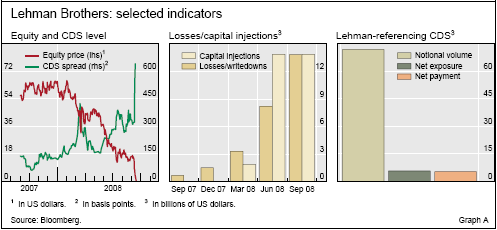Three market implications of the Lehman bankruptcy
(Extract from pages 6-7 of BIS Quarterly Review, December 2008)
Lehman Brothers Holdings Inc (LBHI) filed a petition under Chapter 11 of the US bankruptcy code on 15 September, listing consolidated bank and bond debt of more than $600 billion; its US broker-dealer subsidiary was acquired by Barclays a few days later. The filing marked the first failure of a major investment bank since the demise of Drexel Burnham Lambert in February 1990. Lehman's problems originated from large-scale losses and writedowns taken on exposures to troubled assets and concerns that future losses would outstrip the company's previous efforts to replenish its capital base (Graph A, centre panel). As such, its failure revived questions about investment banks' highly leveraged balance sheets and associated dependence on wholesale funding that had been raised when Bear Stearns had nearly failed in early 2008. Thus, when confidence in the continued viability of the company collapsed (Graph A, left-hand panel), its access to wholesale markets was cut off, forcing Lehman into bankruptcy.1
An event of this magnitude obviously raised a multitude of issues, given the company's size and its central position as a dealer and counterparty in a variety of financial markets. This box discusses three particular market implications linked to the failure of Lehman Brothers that had the potential to cause systemic liquidity disturbances: (1) the impact on the CDS market; (2) the liquidation of money market funds due to losses suffered on Lehman debt; and (3) the consequences of the bankruptcy for the company's prime brokerage clients.
(1) CDS markets
The potential fallout of a Lehman bankruptcy in the $57.3 trillion CDS market2 was the one issue that attracted most attention in the days surrounding the company's bankruptcy filings. The concerns arose from Lehman's central role as a major counterparty and reference entity in that market. It was known that its bankruptcy filing would have two immediate effects: it would trigger default clauses in CDS contracts referencing Lehman, and it would terminate the contracts that the firm had entered into as a counterparty. Netting, settlement and replacement of the respective positions were known to raise operational risks. More importantly, however, no hard public information on the volume of CDS contracts referencing Lehman or the net amounts required to settle them was available at the time of the bankruptcy. The absence of such information created great uncertainty about the capacity of already strained money markets to accommodate the anticipated corresponding liquidity needs.
To manage the situation and address the uncertainties involved, the following initiatives were undertaken. First, a special trading session was organised on Sunday 14 September, right before the bankruptcy filing. The objective was to help the main CDS dealers net out counterparty positions involving Lehman and to rebalance their books through the replacement of trades. Second, following established ISDA (International Swaps and Derivatives Association) procedures, an auction among CDS dealers was conducted on 10 October to determine the recovery rate to be used in the cash settlement of CDS contracts referencing Lehman and, thus, the net amounts to be exchanged between parties.3 Third, the DTCC (Depository Trust and Clearing Corp) made public its count of $72 billion worth of outstanding CDS contracts referencing Lehman and an estimate of $6 billion for related net settlement payments. In the end, on 21 October, a total of $5.2 billion in net payments were made on such contracts (Graph A, right-hand panel). While these relatively modest volumes had no noticeable impact on liquidity conditions at the time of settlement, earlier uncertainties related to these claims are likely to have contributed to volatile conditions in money markets following the bankruptcy filing. Added strains from a potential failure of insurer AIG, in turn, were averted only through a government rescue.
(2) Money market funds
A major source of funding for Lehman was its issuance of commercial paper and other forms of short-dated debt. Money market funds were attracted to these securities by their high credit ratings and yield premiums relative to US government paper. Money market fund investors also felt protected against principal loss because of regulatory restrictions imposed on fund managers and because fund managers had avoided losses in the past.
In the aftermath of the Lehman bankruptcy, 25 money market fund advisers took actions to protect their investors against losses on the company's debt. However, the net asset value of a public money market fund, Reserve Primary, fell below $1.00 per share. As a result, the fund was to be liquidated and distributions made to investors as cash accumulated either through the maturing of portfolio holdings or their sale.
The fund's liquidation prompted massive redemptions by investors in other US money market funds, especially "prime" funds invested in commercial paper. To stop the run on these funds, the US Treasury instituted a temporary programme of insurance for money market fund investors, which was followed up by Federal Reserve rescue programmes aimed at outright purchases of commercial paper and of short-term debt from money market funds (see Box 2 on recent government initiatives).
(3) Prime brokerage activities
Lehman was managed as a global firm, which involved in particular the centralisation in the United States of its funding activities. Despite the global nature of the firm, separate administration and bankruptcy applications were filed by Lehman outside the United States and by the parent firm in New York. These filings in different jurisdictions made this one of the first truly global bankruptcies of a large and complex financial institution. The complexity of the Lehman operation, and the takeover of its US broker-dealer subsidiary immediately after the holding company's bankruptcy filing, raised questions related to the use of different legal procedures across countries for a collapsed firm that was previously managed and run along global product lines. One manifestation of the resulting issues concerns Lehman's prime brokerage activities.
Lehman provided prime brokerage services to a large number of hedge funds. As part of these prime brokerage relationships, hedge funds placed investment assets with Lehman's broker-dealer units in different jurisdictions. These assets, posted as collateral for funding activities, could then be reused by Lehman to meet its own obligations, a process called re-hypothecation. Given its insolvency, many of Lehman's prime brokerage clients suddenly lost access to (and, potentially, part of their claims on) their collateral assets for the duration of the administration process. They were thus forcibly locked into positions of changing value whose future accessibility would depend on different legal proceedings and contractual arrangements in various jurisdictions. To the extent that this resulted in adjustments to the size and location of hedge funds' activities with their prime brokers, the reallocation of funds across jurisdictions, combined with attempts to reduce leveraged risk exposures, would generate potentially sizeable asset sales and withdrawals from individual prime brokerage accounts. These transactions, in turn, would add to pressures in funding and securities lending markets in the wake of the Lehman bankruptcy.
1 On similar cases of bank run-type effects in financial markets, see C Borio, "Market distress and vanishing liquidity: anatomy and policy options", BIS Working Papers, no 158, July 2004.
2 CDS market size is usually measured in notional amounts, while replacement costs are better captured by gross market values (estimated at an overall 5.5% of notional market size in mid-2008).
3 The auction process, defined by ISDA's 2008 Lehman CDS protocol, set the recovery value for Lehman bonds at 8.625%, based on quotes submitted by 14 dealers. As Lehman's bonds had been trading increasingly lower since its bankruptcy filing, the auction price was only slightly lower than bond prices right before the auction, limiting the "gap risk" arising from the auction process.


